‘Puss in Boots: The Last Wish,’ ‘Marcel the Shell With Shoes On’ Directors Reflect on the Voices Behind Their Animated Visions
- Oops!Something went wrong.Please try again later.
- Oops!Something went wrong.Please try again later.
- Oops!Something went wrong.Please try again later.
- Oops!Something went wrong.Please try again later.
- Oops!Something went wrong.Please try again later.
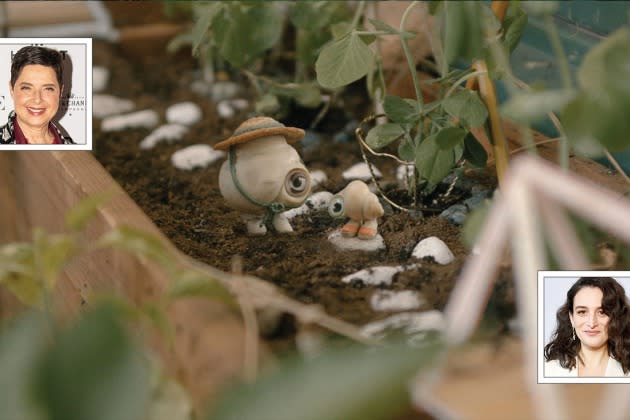
Marcel the Shell With Shoes On
Nana Connie and Marcel (Isabella Rossellini and Jenny Slate)
The birth of the profound and heartwarming 1-inch shell voiced by Jenny Slate was an unusual situation that began years before the movie was made, with a series of animated shorts that Slate wrote with her then-husband, director Dean Fleischer Camp, beginning in 2010.
More from The Hollywood Reporter
Awards Love for 'Marcel the Shell With Shoes On' Leaves Jenny Slate "Very Emotional"
'Paw Patrol' Team on Launching First TV Spinoff Amid Franchise's 10th Anniversary
“It actually was a character that started with her joking around in this tiny voice about how small she felt, and then I developed the design and the animation of Marcel based on that voice,” recalls Camp. “It’s been a very long journey where we are both mutually building upon this original riff and adding parts to his character and to his world. I don’t exactly know how to separate my contributions from hers, because it has been such a mind meld, but I think that Jenny brings a real ability to articulate her emotional landscape in a way that defines the character.”
In the movie, Marcel lives with his grandmother, Nana Connie, voiced by Isabella Rossellini. The character is very much informed by the veteran actress herself. “Everything that people find refreshing and fun and warm and surprising about Nana Connie the character is surprising and interesting and funny about Isabella herself,” says the director. “We got really lucky that Isabella was so generous as a collaborator.”
The director also notes that Rossellini is “often cast in roles that are either glamorous or play into her being Italian or being film royalty.” But, he says, so much of Rossellini’s personality made its way into Connie. “There’s so much to her character. Her curiosity, her warmth, her relationship with nature are really special and informed the character.”
Guillermo del Toro’s Pinocchio
Pinocchio and Geppetto (Gregory Mann and David Bradley)
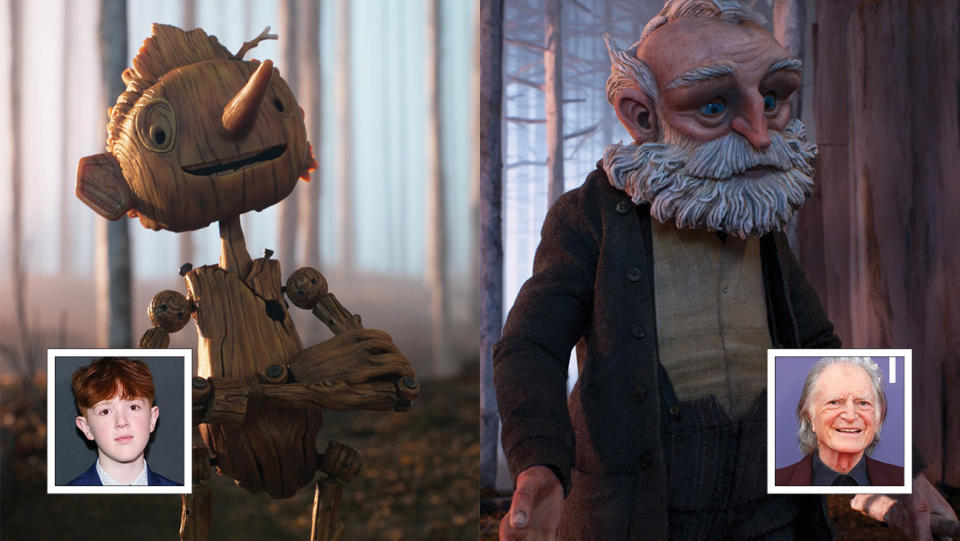
In Guillermo del Toro’s adaptation of Carlo Collodi’s novel for Netflix, del Toro and fellow director Mark Gustafson found Pinocchio’s voice in then-9-year-old Gregory Mann. “I think we found him at the perfect point in his life to play Pinocchio,” says Gustafson. “There was a joy and an innocence and a truth about him at that age that was so pure, and it just popped above everybody else that we listened to. He was our Pinocchio. We knew it immediately.”
Del Toro adds that in directing Mann, they aimed to put him in the same emotional situation as the character — for instance, pairing him with his mother or father when they recorded lines that were in conversation with Geppetto. “He is so real as Pinocchio, heartbreakingly so,” says the two-time Oscar winner, who earned his sixth career Academy Award nom for his animated feature directorial debut.
Geppetto is voiced by David Bradley, with whom del Toro previously collaborated on the television series The Strain and Trollhunters. Del Toro reveals that he’s also writing a part for Bradley in his next film, an adaptation of Frankenstein.
“[Bradley] moves between love and pain in just a beautiful way,” says Gustafson. “And he can do it in just one phrase. He can break your heart.”
Adds del Toro, “He has a unique instrument. He goes up and down and goes baritone. He has that discipline of the English actor [and brings] emotion that is heartbreaking.”
Puss in Boots: The Last Wish
Wolf and Perrito (Wagner Moura and Harvey Guillén)
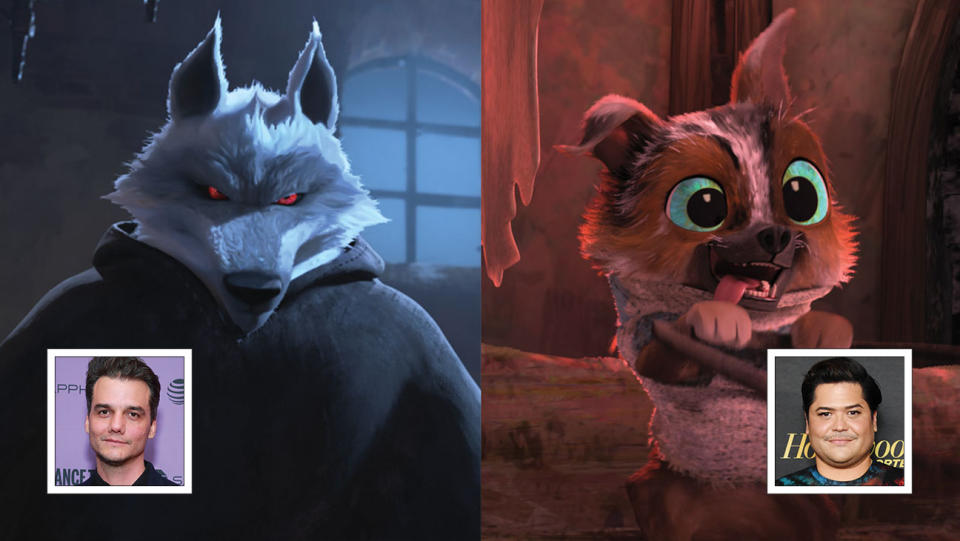
Wolf, the menacing character representing death in DreamWorks Animation’s Puss in Boots: The Last Wish, needed to induce fear in even the bravest of creatures: Puss in Boots. With actor Wagner Moura, perhaps best known for playing the infamous drug trafficker Pablo Escobar in Netflix’s Narcos, director Joel Crawford says they were able to create a character that’s “one part spaghetti Western and then another part supernatural being that has this awkwardness where he’s not used to talking, communicating with people. You can feel that in the rhythms of the dialogue. It just created such a jarring effect; as soon as he speaks onscreen, you can’t help but lean in.”
In contrast, Harvey Guillén’s therapy dog Perrito was brought to the screen not as a chatty sidekick, but rather as an example of an “innocent worldview” who was unafraid to show his vulnerabilities, a counterbalance to the more cynical characters.
“Harvey embodies so much of this sweet, honest, optimistic point of view. He just brings this positivity, this authenticity, to this character,” says the director. “The Wolf dips into the Grimm [brothers’] fairy tales. We wanted to make sure the end feeling coming out of the movie wasn’t dark and scary, but was joyful and grateful and appreciative. You can only feel the light with the dark, for that contrast. And it was just as important, once we found the Wolf, to find the right voice of optimism and hope.”
The Sea Beast
Jacob and Maisie (Karl Urban and Zaris-Angel Hator)
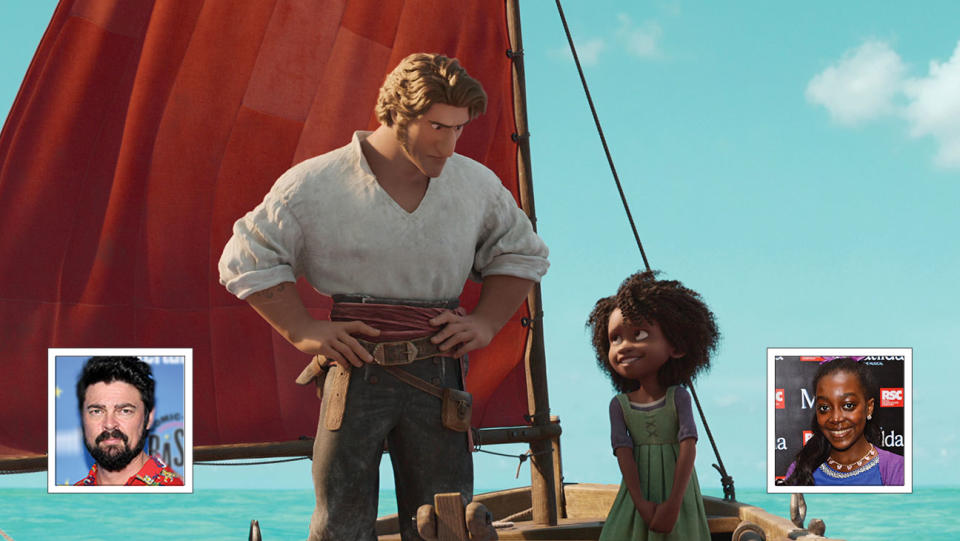
In writer-director Chris Williams’ adventure set in an era of tall ships, he cast Karl Urban to voice Jacob, a brave hero who hunts sea monsters and is willing to risk his life to protect others. Jacob teams up with a strong-willed young girl named Maisie. “Karl was really good at playing that alpha hero character,” says Williams, “but was also really good at playing that character when he was knocked back on his heels and was trying to keep up with this even more powerful and willful character, in Maisie.” The director adds: “He’s a real sweet guy. That comes through in the character.”
For the computer-animated film, which was one of the first projects greenlit by Netflix Animation in 2018 and became the most viewed animated film on the streamer last year, Williams knew he wanted a youngster to play the role of Maisie.
After he’d listened to many auditions, British actress Zaris-Angel Hator stood out. “When we met her, we were totally convinced,” he remembers. “She is a really sweet person [and] she has this determination and this confidence as well, and we knew it was going to be just right for the character. When we put the two of them together, it really was magic, and the chemistry they share is the center of the movie.”
Turning Red
Mei and Ming (Rosalie Chiang and Sandra Oh)
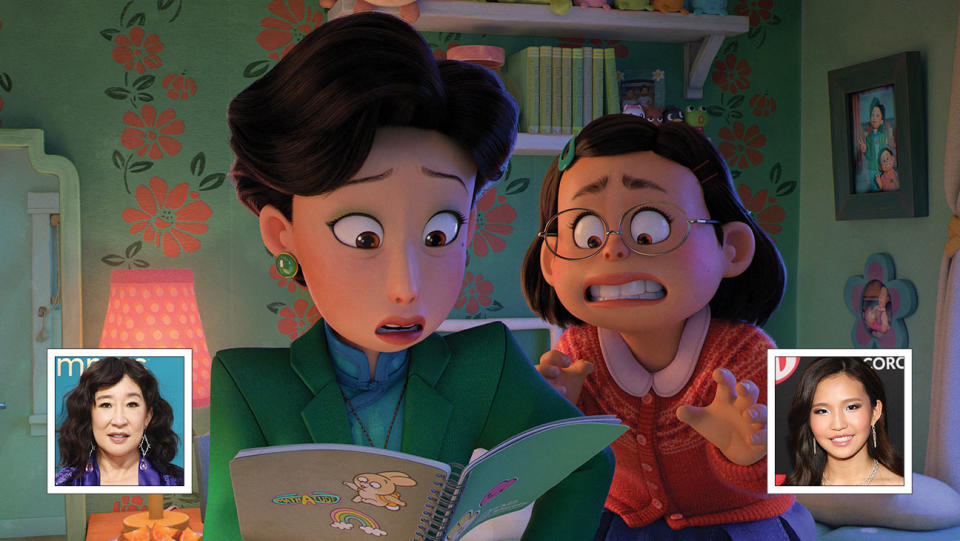
Writer-director Domee Shi’s Turning Red follows a Chinese Canadian teen named Mei and her complicated relationship with her overbearing mother, Ming, voiced by veteran actress Sandra Oh.
Newcomer Rosalie Chiang, who voices Mei, was initially hired to record temp vocals for the Pixar release, bringing an authenticity to the character. When it came time to cast the role, Shi could think of no one else. “Rosalie just immediately had this super charming, natural, dorky voice that just didn’t feel forced,” says Shi. “[In her real life] Rosalie wants to make her mom and her dad proud, and she just can speak so much to our character and her motivation.”
Casting Oh, who like her character is Chinese Canadian, was a no-brainer for the director. “We needed an actress who had the range because Ming is very complex. She is funny, she’s fierce. She is obsessive, but she is vulnerable at the same time,” says Shi, adding that the nuance that Oh brought to the role was important; they didn’t want Ming to turn into a stereotypical tiger mom.
“She approached every line that Ming uttered from the place of just wanting to protect her daughter from all the bad things in the world,” adds Shi. “Even when she’s yelling and saying crazy stuff, you understand where it’s coming from.”
This story first appeared in a Feb. stand-alone issue of The Hollywood Reporter magazine. To receive the magazine, click here to subscribe.

